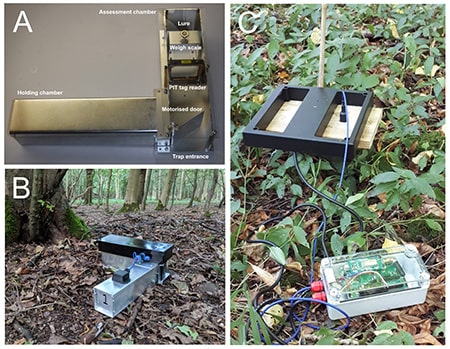
New technology for wildlife monitoring
Much of our fieldwork involves studying wild rodents. To study these animals requires capture, and often longitudinal monitoring. Traditional methods for doing this involve capturing animals in metal traps, often repeatedly in the context of capture-mark-recapture approaches, and radio-tracking. Yet these classic approaches have drawbacks, both in terms of animal welfare, and science. A key issue with standard live traps is that they are indiscriminate, and often capture non-target species as well as individuals for which recapture is not required. Live-trapping has important welfare concerns, including a risk of mortality due to dehydration, hypothermia or insufficient food, particularly for vulnerable non-target species such as shrews, and with intensive trapping. Welfare issues for radio-tracking arise due to the weight and antenna of the radio-collar, which can impede natural animal behaviour, and affect reproduction and survival.
With funding from the NC3Rs, we are pursuing ways to improve animal welfare in small mammal research, while improving data quality along the way. We have recently developed two new RFID-based technology in this vain.
The Smart Trap
Our Smart Trap (Figure 1A, C), provides researchers with selectively over which animals can be trapped according to their body mass and ID (PIT tag). It is also capable of releasing animals back to the wild automatically after a pre-specified holding period (e.g. 30 minutes), allowing for example longitudinal collection of faecal samples from marked individuals without the need for overnight capture. Using Smart Traps, we can eliminate unnecessary bycatch and recaptures, and reduce the time animals spend in traps to the minimum required for research objectives.
RFID Logger
Our RFID logger (Figure 1B) provides a non-invasive way to collect time-stamped data on the whereabouts of PIT-tagged individuals in the field. By placing a set of these loggers across an area, one can gather high quality data on rodent space use and home ranges, social networks, and survival, without the need for repeated capture or radio-collaring. As these loggers are low-power and robust, they run for months at a time before batteries need recharging.
Figure 1: New RFID-based technology for studying wild small mammals

A) Smart Trap with labelled parts
B) Smart Trap in the field
C) RFID logger monitoring mouse movements

